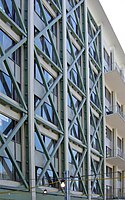
Photo from wikipedia
Abstract The tension behavior of Thread-fixed One-side Bolts (TOB) connected T-stubs at ambient and high temperatures was studied experimentally and theoretically. The anchorage force to TOB was provided by the… Click to show full abstract
Abstract The tension behavior of Thread-fixed One-side Bolts (TOB) connected T-stubs at ambient and high temperatures was studied experimentally and theoretically. The anchorage force to TOB was provided by the threads on the bolt hole wall which was usually restrained by the limited thickness of the steel plate. The thread length and bending strength of the T-stub flange could be increased by adding backing plates. Two failure modes appeared in ambient temperature tests, which were completely flange yielding and flange yielding accompanied with threads failure. Both steady-state method and transient-state method were used in high temperature test. Test results showed that failure modes might be changed at high temperatures. However, the unfavorable threads failure did not appear at high temperatures which showed the good applicability of TOB. Backing plate was proved to be an effective way to strengthen the TOB connected T-stubs. Tension resistance and initial stiffness of strengthened T-stubs increased obviously while still keeping good ductility in both ambient and high-temperature circumstance. In transient-state test, the increase in load ratio would make the connection more fragile. The failure temperature and failure displacement decreased correspondingly. Design equations for predicting the failure mode and the tension strength of TOB connected T-stubs at high temperatures were proposed, considering effects of large deformation of the T-stub flange at high temperatures. Comparison with test results showed that the proposed design equations could precisely predict the failure mode and the yielding tension strength of strengthened or unstrengthened TOB connected T-stubs at both ambient and high temperatures.
Journal Title: Journal of Constructional Steel Research
Year Published: 2020
Link to full text (if available)
Share on Social Media: Sign Up to like & get
recommendations!